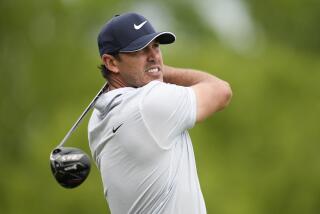Becker’s Loss Could Open It Up for Connors : Tennis: Haarhuis takes advantage of No. 1 player’s injury, and 38-year-old rolls on.
- Share via
NEW YORK — Bearded, beaten, but not all that bewildered, Boris Becker made his exit from the U.S. Open Saturday, beating a hasty straight-set retreat to the sidelines that just may open up the draw for . . .
(Are you ready?)
Jimmy Connors.
Becker absorbed a 6-3, 6-4, 6-2, third-round defeat by Dutch-born, Florida State-educated Paul Haarhuis, then offered a simple explanation for what had transpired on the court: “I lost.”
Actually, Becker could have listed some extenuating circumstances, notably, how he was hampered because of a pulled muscle in his right leg, injured in his first-round match with Martin Jaite.
“I was always two, three steps slow, that is why I lost,” Becker said. “Every time I put my weight on it, it doesn’t hold up. The back of my leg I use (for) most of my strokes and my serve when I land, on the volley.
“It affected my whole game.”
Becker served nine aces, but made 35 unforced errors--most of them occurring from his usually reliable backhand side--and went out in a minute short of two hours.
Thus ended Becker’s second-worst U.S. Open, exceeded in futility only by his second-round straight-set loss to Darren Cahill three years ago.
It wasn’t exactly what the No. 1-ranked and top-seeded player had in mind, especially in a third-round match against a lightly regarded opponent such as Haarhuis, 25, who burst upon tennis’ consciousness with a second-round upset of four-time champion John McEnroe in the 1989 Open.
Haarhuis was such an unknown then, that when he was asked where he was from, he said he came from Mars.
After beating Becker, he was asked how to say his name.
“Paul,” said Haarhuis (pronounced HAR-whose).
Meanwhile, the man with the most enduring name in men’s tennis advanced to the fourth round. Jimmy Connors routed clay-court specialist Karel Novacek, 6-1, 6-4, 6-3, in 1 hour 42 minutes to put himself into the fourth round against Aaron Krickstein.
Where Connors goes from there is really up to him, but Becker’s defeat ensures that Connors would not have to face a seeded player until the semifinals.
“What happens next, could be a letdown, could be moving up to the next level, that’s what I’m here for,” he said. “Let’s just see what happens.”
A full house of nearly 20,000 was on hand to see Connors become the beneficiary of an astounding 65 unforced errors by Novacek, who also provided Connors with 16 break-point opportunities.
Connors, who never faced a break point on his own serve, won 88% of his first-serve points and immediately placed his victory in perspective: “I made it to Monday (his 39th birthday), that’s for sure.”
So did defending champion Pete Sampras, who entered the fourth round after slugging his way past qualifier Stephane Simian, a 24-year-old Frenchman who turned pro in January and had not won a match until the first round of the Open this week.
Sampras worked hard for a 7-6 (7-3), 6-4, 6-7 (7-4), 6-3 decision over Simian, an All-American at South Carolina in 1989 and 1990, who came into the Open ranked No. 257, but he became the first player to win a set from Sampras.
At the same time, Sampras said he is not looking forward to a potential semifinal showdown with Connors, who seems to have branded the Open as his own.
“It’s his tournament,” Sampras said. “I mean, he won five times. He is so popular here and the crowd wants him to win. He is playing great tennis and you know obviously the draw has opened up for him . . . as far as Becker losing.”
As Becker’s Open came to a close, his leg injury could affect his next event--Germany’s Davis Cup semifinal against the United States later this month in Kansas City, Mo.
Becker claimed there is a real chance he might not be able to play against the Americans Sept. 20-22 at Kemper Arena.
“Well, at this stage, I cannot really play and I can now only play Davis Cup if I am fit,” he said. “Until then, I just have to go home and hopefully it is going to be better by then. (The leg) is pretty bad.”
More to Read
Go beyond the scoreboard
Get the latest on L.A.'s teams in the daily Sports Report newsletter.
You may occasionally receive promotional content from the Los Angeles Times.










